Rh 인자 부적합으로 인한 신생아 황달(Rh 부적합 황달), Neonatal jaundice due to Rh incompatibility(Rh incompatibility jaundice/Rh incompatibility)
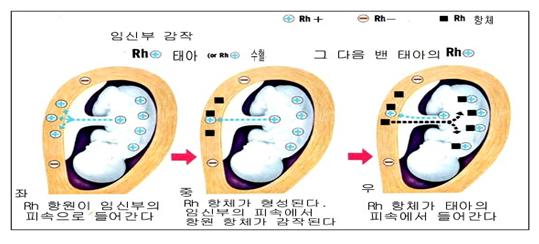
그림 124.Rh 인자 부적합으로 인한 신생아 황달이 생기는 기전(1)
그림 좌; 태아의 Rh(+)항원이 임신부의 Rh(-) 핏 속으로 들어간다.
그림 중; 임신부의 핏 속 Rh(-) 적혈구들이 감작되어 태아 Rh(+) 적혈구에 대한 Rh 항체(-)가 생긴다.
그림 우; 임신부의 핏 속에 생긴 Rh 항체(-)가 태아의 핏 속으로 들어가 태아의 Rh(+) 적혈구에 부착된다(-+).
그림 좌와 그림 중; Rh(-) 를 가진 여성(임신되지 않은)이나 임신부가 Rh(+) 인자 피를 수혈 받으면 그 여성의 적혈구는 Rh(+) 인자 항원에 대해서 감작된다.
그림 우; 그 다음 임신됐을 때 태아의 Rh 인자가 Rh(+)일 때 그 태아와 신생아에게 Rh 인자 부적합으로 Rh 부적합 황달이 생길 수 있다.
Used with permission from Ross Laboratories, Columbus, Ohio 43216, Division of Laboratories, USA와 소아가정간호백과
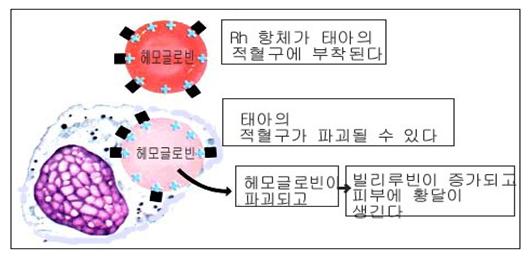
그림 125.Rh 부적합으로 인한 신생아 황달이 생기는 기전(2)
그림 상; Rh(+) 항체(-)가 태아의 적혈구 Rh(+) 항원에 부착된다(-+).
이 때 태아의 적혈구들이 용혈되고 직접형 쿰스 검사가 양성으로 나타난다.
그림 하; Rh(+)을 가진 태아의 적혈구들이 파괴되고 빈혈과 황달이 생길 수 있다. 이 때 적혈구 속 헤모글로빈도 파괴되고 간접형 빌리루빈이 생성된다. 그리고 피부가 노랗게 된다.
심한 경우에는 뇌에 핵황달이 생길 수 있다.
Used with permission from Ross Laboratories, Columbus, Ohio 43216, Division of Laboratories, USA와 소아가정간호백과

그림 126. Rh(+) 인자를 가진 태아의 적혈구들이 파괴되고 빈혈과 황달이 생길 수 있다(좌).
이 때 적혈구 속 헤모글로빈이 파괴되고 간접형 빌리루빈이 생성된다.
피부가 노랗게 된다.
심한 경우에는 뇌에 핵황달이 생길 수 있고
태아 부종도 생길 수 있다(우).
참고문헌;Used with permission from Clinical Educational Aid, Ross Labotories,Columbus, Ohio,USA와 소아가정간호백과
- 혈액형에는 A, B, AB, O형 등이 있다.
- Rh 인자는 Rh 양성과 Rh 음성이 있다.
- Rh 양성을 Rh(+)로, Rh 음성을 Rh(-)로 표현 한다.
- 임신부의 Rh 인자가 음성이고 태아의 Rh 인자가 양성인 경우 신생아에게 Rh 인자 부적합이 생길 수 있다.
- 자궁 내 Rh 인자 부적합이 생겨 있던 태아가 태어나자마자 신생아의 적혈구들은 Rh인자 부적합으로 심하게 용혈될 수 있다.
- 갓 태어난 아기의 혈 중 간접형 빌리루빈의 농도가 비정상적으로 증가되고 혈중 헤모글로빈의 농도가 비정상적으로 감소된다.
- 이 때 신생아의 적혈구들이 심하게 용혈되고 심한 황달과 심한 빈혈이 생길 수 있다.
- 한인 5백 명 중 1명의 Rh 인자가 음성이라고 한다.
- 따라서 한인 신생아들에겐 Rh 인자 부적합으로 생기는 신생아 황달 발생률은 아주 낮다.
- 신생아에게 Rh 인자 부적합으로 황달이 생길 때는 신속하고 적절하게 치료하지 않으면 신생아의 생명을 위협할 수 있다.
- Rh(-) 인자를 가진 임신부는 Rh 인자 부적합과 그로 인한 신생아 황달에 대해 특히 잘 알아둘 필요가 있다.
- 이런 이유로 모든 임신부는 Rh 인자 검사를 임신 중 기본으로 검사해야 한다. [부모도 반의사가 되어야 한다- 소아가정간호백과]-제 25권 임신, 분만, 신생아 돌보기-피검사 참조.
| Rh 인자 부적합으로 인한 신생아 황달(Rh 부적합 황달)의 원인 |
- 임신부의 Rh 인자가 Rh(-)이고, 남편의 Rh 인자가 Rh(+)일 경우, 임신부의 태아의 Rh 인자가 Rh(+)일 가능성은 50%이다.
- 만일 임신부의 Rh 인자가 Rh(-)이고 태아의 Rh 인자가 Rh(+)일 경우에는 태아의 적혈구들이 태반을 통과하여 임신부의 핏속으로 들어가서 Rh(+)를 가진 태아의 적혈구가 파괴될 수 있는 Rh 항체가 임신부의 체내에서 형성된다.
- 태아의 적혈구에 해로운 Rh 항체가 임신부의 핏속에서 만들어진 후 그 항체가 태반을 통과하여 태아의 핏속으로 들어간다.
- 이 때 임신부의 Rh 항체가 Rh(+)항원을 가진 태아의 적혈구들에 붙고 Rh(+)항원과 Rh(+)항체가 감작되어 결국 태아의 적혈구들이 용혈 된다.
- 이 때 태아의 핏속 적혈구들이 많이 용혈 될 수 있기 때문에 태아의 핏속에 간접형 빌리루빈의 농도가 증가되어 태아에게 황달이 심하게 생길 수 있고 빈혈도 심하게 생길 수 있다.
- 분만 중 자궁벽에 붙은 태반의 일부가 자궁 내벽에서 조금 떨어질 수 있다.
- 이때도 태아의 피가 모체의 핏속으로 들어갈 수 있다.
- Rh(+)를 가진 태아의 피가 Rh(-)를 가진 임신부의 핏속으로 들어갈 때 태아의 적혈구들이 파괴될 수 있는 Rh 항체가 모체 내에서 만들어 질 수 있다.
- 그러나 Rh 항체를 만드는 데는 상당한 시간이 요한다.
- 그래서 Rh(-)를 가진 임신부가 Rh(+)를 가진 태아를 처음으로 임신했을 때는 임신부에게서 만들어진 Rh 항체가 그 태아의 핏속으로 들어가서 처음 임신된 태아에게 Rh 인자 부적합을 일으킬 시간 여유가 없다.
- 이런 이유 때문에 Rh(-)를 가진 임신부가 첫 임신을 했을 때 Rh(+)를 가지고 있는 첫 태아에게는 Rh 인자 부적합으로 인한 신생아 황달이 잘 생기지 않는 것이 보통이다.
- Rh(+)를 가진 아기를 처음 임신 분만 한 후 Rh(-)를 가진 엄마에게 RhO(D)면역 글로불린주사를 맞아 예방적 치료를 받지 않은 산모에게 두 번째로 임신된 태아의 Rh 인자가 Rh(+)항원을 가진 경우 두 번째로 태어난 태아에게 Rh 인자 부적합이 생길 수 있고 출생 후 그 신생아에게 Rh 인자 부적합으로 인한 황달과 빈혈이 심하게 생길 수 있다.
| Rh 인자 부적합으로 인한 신생아 황달(Rh 부적합 황달)의 증상 징후 |
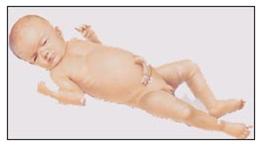
그림 127. 심한 Rh 인자 부적합으로 생기는 신생아 황달로 피부가 노랗다. 뇌에 핵황달이 생길 수 있다.
참고문헌;Used with permission from Clinical Educational Aid, Ross Labotories,Columbus, Ohio,USA와 소아가정간호백과
- Rh(-)를 가진 임신부가 Rh(+)를 가진 아기를 분만한 후, 그 다음에 임신해 낳는 신생아의 Rh 형이 Rh(+)일 때는 그 신생아에게 Rh 인자 부적합으로 황달과 빈혈이 생길 수 있는 확률은 거의 100%이다.
- 이 경우, 태아나 신생아의 적혈구들이 심하게 용혈 될 수 있고 그에게 심한 황달과 빈혈이 생길 수 있다.
- 자궁 내 태아의 적혈구들이 계속 용혈 되어 간과 비장 등이 비정상적으로 커질 수 있다.
- Rh 인자 부적합이 있는 신생아는 출생 첫날부터 심한 황달에 걸일 수 있다.
- 신생아의 피부색이 노랗고 심한 빈혈로 피부가 창백할 수 있다.
- 간과 지라가 붓고 배가 부를 수 있다.
- 태어나자마자 이 병은 Rh 부적합증(Rh incompatibility)이라고 한다.
- Rh 부적합증을 적절히 속히 치료하지 않으면 핏속 간접형 빌리루빈의 농도가 20mg/dl 이상으로 올라갈 수 있고 Rh 인자 부적합으로 인한 황달 및, 또는 핵황달이 생길 수 있다.
- 핵황달로 뇌성마비가 생길 수 있고 전신경련을 할 수 있다.
- 필요에 따라 RhO(D) 글로불린(로감) 주사를 산모가 맞아 Rh 인자 부적합으로 인한 황달을 예방할 수 있다.
- Rh(-) 인자를 가진 임신부가 낙태를 하거나 유산을 하거나 Rh(+)를 가진 아기를 낳은 후 72시간 내에 로감주사를 맞으면, Rh 인자 부적합으로 생기는 Rh 항체가 엄마에게 만들어지지 않아 Rh 인자 부적합이 다음 임신된 태아에게 생기지 않는다.
| Rh 인자 부적합으로 인한 신생아 황달(Rh 부적합 황달)의 진단 |
- 부인이 Rh 혈액형이 Rh(-)이고 남편의 Rh 혈액형이 Rh(+) 일 때 부인이 임신하면 태아에게 Rh 인자 부적합으로 황달이 생길 수 있는지 곧 알아야 한다.
- 특히 처음 임신을 해서 Rh(+)를 가진 아기를 출산한 후 또는 임신했을 때 유산이나 낙태를 한 후 임신을 또 했을 때는 Rh 인자 부적합으로 황달이 생기는지 반드시 알아봐야 한다.
- 태아의 Rh(+)인자가 임신부의 Rh 인자에 부적합한지를 알기 위해 임신부의 피를 검사하여 알아볼 수 있다.
- 임신 중 양수검사로 태아의 간접형 빌리루빈의 혈중 농도를 간접적으로 알아볼 수 있다.
- 태아의 핏속에 간접형 빌리루빈의 농도가 정상 이상 높으면 태아의 피를 다른 사람의 피로 전부 바꿔 주는 교환수혈 치료를 한다.
- 갓 태어난 신생아에게 Rh 부적합으로 인해서 Rh 부적합 황달이 생길 것이 예측되면 태어나자마자 갓 태어난 아기의 피를 검사해 갓 태어난 아기가 Rh(+)혈액형을 갖고 있는지 또는 Rh(-)혈액형을 갖고 있는지 확인해야 한다.
- 갓 태어난 신생아가 Rh(+)혈액형을 가지고 있으면 임신 중 엄마에게서 만들어진 Rh(+)항체가 갓 태어난 신생아의 적혈구들에 붙어 있는지 알아볼 수 있는 쿰스 검사를 하고 아기 핏속 간접형 빌리루빈 혈중 농도 등을 측정해서 진단한다.
- CBC 피 검사와 그 외 다른 혈액검사 등으로 진단한다.

그림 128.양수 검사를 하기 위해 바늘로 양수를 뽑는다. 양수검사를 해 태아의 간접형 빌리루빈 농도를 알아볼 수 있다.
Copyright ⓒ 2012 John Sangwon Lee, MD., FAAP
| Rh 인자 부적합으로 인한 신생아 황달(Rh 부적합 황달)의 치료 |
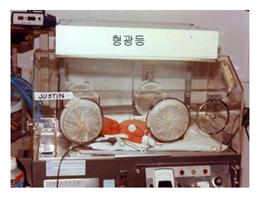
사진 129. 심한 신생아 황달은 빌리루빈 광선으로도 치료한다.
Copyright ⓒ 2012 John Sangwon Lee, MD., FAAP
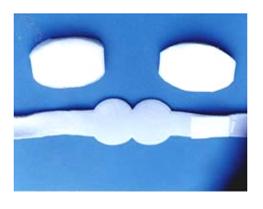
사진 130. 황달을 빌리루빈 광선으로 치료할 때 눈을 가리는 데 쓰는 안대
Copyright ⓒ 2012 John Sangwon Lee, MD., FAAP
- Rh 부적합으로 인한 신생아 황달이 있다고 의심되면 즉시 병원 신생아 집중 치료실에서 입원 진단 치료를 받아야 한다.
- 간접형 빌리루빈 농도, 쿰스 검사(테스트), 헤모글로빈 농도검사의 결과와 증상 징후 등에 따라서 치료한다.
- Rh 인자 부적합으로 생긴 황달의 증세가 경미할 때는 간접형 빌리루빈 농도를 반복 추적 검사하면서 그 검사 결과에 따라 그때그때 적절히 치료할 수 있다.
- 간접형 빌리루빈의 농도가 비정상적으로 계속 증가되는지 조심히 관찰하다가 그의 농도가 20mg/dl 이상 더 올라가기 전 교환수혈 치료를 하기도 한다.
- 아기의 피 전체를 다른 사람의 피로 전부 교환해 주는 수혈 치료 방법을 교환수혈이라 한다.
- Rh 인자 부적합으로 심한 황달이 생길 것을 예상할 때는 간접형 빌리루빈의 농도가 20mg/dl 이상 더 올라가기 훨씬 이전 교환수혈 치료를 해 핵황달이 생기지 않게 예방적 치료를 해 주는 동시 황달도 치료한다.
- 간접형 빌리루빈 농도가 20mg/dl 이상으로 증가되어 핵황달이 일단 생기면 핵황달을 적절히 치료할 수 있는 방법도 특효약도 없다.
- 핵황달이 생기면 뇌성마비가 생길 수 있고 사망할 수 있다.
| Rh 인자 부적합으로 인한 신생아 황달(Rh 부적합 황달)의 예방 |
- 분만 전 정기 검진을 받을 때 모든 임신부의 Rh 인자가 Rh(+)인지 또는 Rh(-)인지 검사받아야 한다.
- 임신부의 Rh 인자가 Rh(-)이면 남편의 Rh 인자가 Rh(-)인지 또는 Rh(+)인지도 알아본다.
- 임신부의 Rh 인자가 Rh(-)이고 남편의 Rh 인자가 Rh(+)인 경우, 그 임신부가 처음 낳은 신생아의 Rh 인자가 Rh(+)인지 Rh(-)인지 출생 후 곧 검사한다.
- 신생아의 Rh 인자가 Rh(+)이면 분만 후 72시간 이내에 로감(Rho GAM/항 Rho(D) 면역글로불린) 주사를 Rh(-)인 산모에게 주사해 다음 임신할 아기에게 Rh 인자 부적합으로 황달이 생기지 않게 예방한다.
- Rh(-)를 가진 임신부가 낙태나 유산됐을 때 역시 로감주사를 맞아 이 병이 생기지 않게 예방적 치료를 한다.
Neonatal jaundice due to Rh incompatibility (Rh incompatibility jaundice/Rh incompatibility)

Figure 124. Mechanism of neonatal jaundice due to Rh factor incompatibility
(1) Figure left; The fetal Rh(+) antigen enters the pregnant woman’s Rh(-) bloodstream. in painting; Rh(-) red blood cells in the pregnant woman’s blood are sensitized to produce Rh antibodies (-) against fetal Rh(+) red blood cells. Picture Wu; The Rh antibody (-) generated in the blood of a pregnant woman enters the blood of the fetus and attaches to the Rh (+) red blood cells of the fetus (-+).
Figure left and Figure middle; When a woman with Rh(-) (not pregnant) or a pregnant woman receives Rh(+) factor blood, her red blood cells are sensitized to the Rh(+) factor antigen. Picture Wu; Then, when pregnant, when the fetus’ Rh factor is Rh (+), the fetus and her newborn baby may develop Rh incompatibility jaundice due to Rh factor incompatibility. Used with permission from Ross Laboratories, Columbus, Ohio 43216, Division of Laboratories, USA and the Encyclopedia of Pediatric and Family Nursing

Figure 125. Mechanism of neonatal jaundice due to Rh incompatibility
(2) picture award; Rh(+) antibody (-) attaches to fetal red blood cell Rh(+) antigen (-+).
At this time, the fetal red blood cells are hemolyzed and the direct Coombs test is positive. picture ha; The red blood cells of the fetus with Rh(+) are destroyed, and anemia and jaundice may develop. At this time, hemoglobin in red blood cells is also destroyed and indirect type bilirubin is produced. And the skin turns yellow. In severe cases, nuclear jaundice can occur in the brain. Used with permission from Ross Laboratories, Columbus, Ohio 43216, Division of Laboratories, USA and the Encyclopedia of Pediatric and Family Nursing

Figure 126. The red blood cells of the fetus with Rh(+) factor are destroyed and anemia and jaundice may occur (left). At this time, hemoglobin in red blood cells is destroyed and indirect type bilirubin is produced. The skin turns yellow. In severe cases, nuclear jaundice can occur in the brain. Fetal edema may also occur (right). References: Used with permission from Clinical Educational Aid, Ross Laboratories, Columbus, Ohio, USA and the Encyclopedia of Pediatric and Family Nursing
• Blood types include A, B, AB, and O blood types.
• Rh factor has Rh-positive and Rh-negative.
• Rh-positive is expressed as Rh(+) and Rh-negative as Rh(-).
• If the pregnant woman’s Rh factor is negative and the fetus’s Rh factor is positive, the newborn may have Rh factor incompatibility.
• As soon as a fetus with intrauterine Rh factor incompatibility is born, the newborn’s red blood cells may be severely hemolyzed due to Rh factor incompatibility.
• The concentration of indirect bilirubin in the blood of a newborn baby is abnormally increased and the concentration of hemoglobin in the blood is abnormally decreased.
• At this time, the newborn’s red blood cells are severely hemolyzed, and severe jaundice and severe anemia may occur.
• One out of 500 Koreans is said to have a negative Rh factor.
• Therefore, the incidence of neonatal jaundice due to Rh factor incompatibility among Korean newborns is very low.
• Jaundice caused by Rh factor incompatibility in newborns can be life-threatening if not treated promptly and appropriately.
• Pregnant women with Rh(-) factors need to be particularly aware of Rh factor incompatibility and resulting jaundice in newborns.
• For this reason, all pregnant women should have an Rh factor test done as a standard during pregnancy.
www.drleepediatrics.com-Vol. 25 Pregnancy, childbirth, and newborn care-Refer to a blood test.
Causes of neonatal jaundice due to Rh factor incompatibility (Rh incompatibility jaundice)
• If a pregnant woman’s Rh factor is Rh(-) and her husband’s Rh factor is Rh(+), there is a 50% chance that the pregnant woman’s fetal Rh factor is Rh(+).
• If the pregnant woman’s Rh factor is Rh(-) and the fetus’s Rh factor is Rh(+), the fetal red blood cells may pass through the placenta into the pregnant woman’s blood and destroy the fetal red blood cells with Rh(+). Rh antibodies are formed in the body of pregnant women.
• Rh antibodies, which are harmful to the red blood cells of the fetus, are produced in the mother’s blood and then pass through the placenta into the blood of the fetus.
• At this time, the pregnant woman’s Rh antibody attaches to the red blood cells of the fetus with the Rh(+) antigen, and the Rh(+) antigen and the Rh(+) antibody are sensitized, and eventually the red blood cells of the fetus are hemolyzed.
• At this time, because a lot of red blood cells in the fetus can be hemolyzed, the concentration of indirect bilirubin in the blood of the fetus is increased, which can cause severe jaundice and severe anemia.
• During labor, part of the placenta attached to the uterine wall may come off the lining of the uterus.
• Even at this time, the blood of the fetus may enter the blood of the mother.
• When the blood of a fetus with Rh(+) enters the blood of a pregnant woman with Rh(-), Rh antibodies that can destroy the fetal red blood cells can be produced in the mother.
• However, it takes a considerable amount of time to make Rh antibodies.
• So, when a pregnant woman with Rh(-) becomes pregnant for the first time with a fetus with Rh(+), there is not enough time for the Rh antibody produced by the pregnant woman to enter the fetus’s blood and cause Rh factor incompatibility in the first-born fetus.
• For this reason, when a pregnant woman with Rh(-) becomes pregnant for the first time, it is not common for the first fetus with Rh(+) to develop neonatal jaundice due to Rh factor incompatibility.
• After giving birth to a baby with Rh(+) for the first time, the mother with Rh(-) received an injection of RhO(D) immunoglobulin, and the Rh factor of the fetus of the second pregnancy was given to a mother who did not receive prophylactic treatment. In the case of (+) antigen, the second-born fetus may develop Rh factor incompatibility, and after birth, the newborn may develop severe jaundice and anemia due to Rh factor incompatibility.
Signs, symptoms of neonatal jaundice due to Rh factor incompatibility (Rh incompatibility jaundice)

Figure 127. Yellow skin due to neonatal jaundice due to severe Rh factor incompatibility. Nuclear jaundice may occur in the brain. References: Used with permission from Clinical Educational Aid, Ross Laboratories, Columbus, Ohio, USA and the Encyclopedia of Pediatric and Family Nursing
• After a pregnant woman with Rh(-) gives birth to a baby with Rh(+), if the Rh type of the newborn is Rh(+), the newborn may develop jaundice and anemia due to Rh factor incompatibility. The probability of that happening is almost 100%.
• In this case, the red blood cells of the fetus or newborn may be severely hemolyzed and he may develop severe jaundice and anemia.
• Abnormal enlargement of the liver and spleen may occur due to continued hemolysis of fetal red blood cells in the womb.
• Newborns with Rh factor incompatibility may develop severe jaundice from the first day of life.
• Newborns may have yellow skin and pale skin due to severe anemia.
• Liver and spleen may become swollen and full.
• Immediately after birth, this disease is called Rh incompatibility.
• If Rh incompatibility is not treated properly and promptly, the concentration of indirect bilirubin in the blood may rise to more than 20 mg/dl, and jaundice and/or nuclear jaundice due to Rh factor incompatibility may occur.
• Nuclear jaundice in the brain can cause cerebral palsy and generalized convulsions.
• RhO(D) globulin (RhoGAM) injection can be given to the mother as needed to prevent jaundice caused by Rh factor incompatibility.
• If a pregnant woman with the Rh(-) factor has an abortion, miscarriage, or receives a Rogam injection within 72 hours after giving birth to a baby with Rh(+), the Rh antibody caused by the Rh factor incompatibility will not be made in the mother, so the mother is not suitable This does not occur to the fetus then conceived.
Diagnosis of neonatal jaundice due to Rh factor incompatibility (Rh incompatibility jaundice)
• When your wife’s Rh blood type is Rh(-) and her husband’s Rh blood type is Rh(+) if the wife becomes pregnant, it is important to know soon if the fetus can develop jaundice due to Rh factor incompatibility.
• In particular, after giving birth to a baby with Rh(+) during pregnancy, or after a miscarriage or abortion during pregnancy, it is essential to check whether jaundice occurs due to Rh factor incompatibility.
• To determine whether the fetal Rh(+) factor is unsuitable for the pregnant woman’s Rh factor, it can be checked by examining the pregnant woman’s blood.
• Amniocentesis during pregnancy can indirectly determine the blood level of indirect bilirubin in the fetus.
• If the concentration of indirect bilirubin in the blood of the fetus is higher than normal, exchange transfusion treatment is performed in which all the blood of the fetus is replaced with that of another person.
• If it is predicted that a newborn will develop Rh incompatibility jaundice due to Rh incompatibility, the newborn’s blood should be tested immediately after birth to determine whether the newborn baby has an Rh(+) or Rh(-) blood type.
• If a newborn baby has Rh(+) blood type, a Coombs test is performed to determine whether the Rh(+) antibody produced by the mother during pregnancy is attached to the newborn’s red blood cells, and the indirect bilirubin blood level in the baby’s blood is measured. to diagnose
• Diagnosis is made by CBC blood test and other blood tests.

Figure 128. Draw amniotic fluid with a needle to test for amniotic fluid. Amniocentesis can be done to determine the level of indirect bilirubin in the fetus. Copyright ⓒ 2012 John Sangwon Lee, MD., FAAP
Treatment of neonatal jaundice due to Rh factor incompatibility (Rh incompatibility jaundice)

Picture 129. Severe neonatal jaundice is also treated with bilirubin light. Copyright ⓒ 2012 John Sangwon Lee, MD., FAAP

Photo 130. Eye patch is used to cover the eyes when jaundice is treated with bilirubin light. Copyright ⓒ 2012 John Sangwon Lee, MD., FAAP
• If you suspect your newborn has neonatal jaundice due to Rh incompatibility, you should immediately seek inpatient diagnostic treatment in a hospital neonatal intensive care unit.
• Treat according to the results of indirect bilirubin concentration, Coombs test (test), hemoglobin concentration test, and symptoms.
• When the symptoms of jaundice caused by Rh factor incompatibility are mild, the indirect bilirubin concentration can be repeatedly followed up and treated appropriately depending on the test results.
• After carefully observing whether the concentration of indirect bilirubin continues to increase abnormally, exchange transfusion therapy is sometimes performed before the concentration of indirect bilirubin rises more than 20mg/dl.
• A transfusion treatment method in which the entire baby’s blood is exchanged for another person’s blood is called an exchange transfusion.
• When severe jaundice is expected due to Rh factor incompatibility, exchange transfusion treatment is performed long before the concentration of indirect bilirubin rises more than 20mg/dl to prevent nuclear jaundice from occurring, and jaundice is also treated.
• Once nuclear jaundice occurs due to an increase in the concentration of indirect bilirubin above 20 mg/dl, there is no effective method to properly treat nuclear jaundice.
• Nuclear jaundice can result in cerebral palsy and death.
Prevention of neonatal jaundice due to Rh factor incompatibility (Rh incompatibility jaundice)
• When receiving regular check-ups before delivery, all pregnant women should be tested to determine whether the Rh factor is Rh(+) or Rh(-).
• If the pregnant woman’s Rh factor is Rh(-), find out whether her husband’s Rh factor is Rh(-) or Rh(+).
• If a pregnant woman’s Rh factor is Rh(-) and her husband’s Rh factor is Rh(+), check whether the Rh factor of the pregnant woman’s first child is Rh(+) or Rh(-) immediately after birth.
• If the newborn’s Rh factor is Rh(+), inject Rho GAM (anti-Rho(D) immunoglobulin) injection to the Rh(-) mother within 72 hours after delivery. prevent this from happening.
• If a pregnant woman with Rh(-) has an abortion or miscarriage, she should also receive Rogam injection to prevent this disease from occurring.
출처 및 참조문헌
- Nelson Textbook of Pediatrics 22ND Ed
- The Harriet Lane Handbook 22ND Ed
- Growth and development of the children
- www.drleepediatrics.com 제1권 소아청소년 응급 의료
- www.drleepediatrics.com 제2권 소아청소년 예방
- www.drleepediatrics.com 제3권 소아청소년 성장 발육 육아
- www.drleepediatrics.com 제4권 모유,모유수유, 이유
- www.drleepediatrics.com 제5권 인공영양, 우유, 이유식, 비타민, 미네랄, 단백질, 탄수화물, 지방
- www.drleepediatrics.com 제6권 신생아 성장 발육 육아 질병
- www.drleepediatrics.com제7권 소아청소년 감염병
- www.drleepediatrics.com제8권 소아청소년 호흡기 질환
- www.drleepediatrics.com제9권 소아청소년 소화기 질환
- www.drleepediatrics.com제10권. 소아청소년 신장 비뇨 생식기 질환
- www.drleepediatrics.com제11권. 소아청소년 심장 혈관계 질환
- www.drleepediatrics.com제12권. 소아청소년 신경 정신 질환, 행동 수면 문제
- www.drleepediatrics.com제13권. 소아청소년 혈액, 림프, 종양 질환
- www.drleepediatrics.com제14권. 소아청소년 내분비, 유전, 염색체, 대사, 희귀병
- www.drleepediatrics.com제15권. 소아청소년 알레르기, 자가 면역질환
- www.drleepediatrics.com제16권. 소아청소년 정형외과 질환
- www.drleepediatrics.com제17권. 소아청소년 피부 질환
- www.drleepediatrics.com제18권. 소아청소년 이비인후(귀 코 인두 후두) 질환
- www.drleepediatrics.com제19권. 소아청소년 안과 (눈)질환
- www.drleepediatrics.com 제20권 소아청소년 이 (치아)질환
- www.drleepediatrics.com 제21권 소아청소년 가정 학교 간호
- www.drleepediatrics.com 제22권 아들 딸 이렇게 사랑해 키우세요
- www.drleepediatrics.com 제23권 사춘기 아이들의 성장 발육 질병
- www.drleepediatrics.com 제24권 소아청소년 성교육
- www.drleepediatrics.com 제25권 임신, 분만, 출산, 신생아 돌보기
- Red book 29th-31st edition 2021
- Nelson Text Book of Pediatrics 19th- 21st Edition
- The Johns Hopkins Hospital, The Harriet Lane Handbook, 22nd edition
- 응급환자관리 정담미디어
-
소아가정간호백과–부모도 반의사가 되어야 한다, 이상원
-
Neonatal Resuscitation American heart Association
-
Neonatology Jeffrey J.Pomerance, C. Joan Richardson
-
Pediatric Resuscitation Pediatric Clinics of North America, Stephen M. Schexnayder, M.D.
-
Pediatric Critical Care, Pediatric Clinics of North America, James P. Orlowski, M.D.
-
Preparation for Birth. Beverly Savage and Dianna Smith
-
Infectious disease of children, Saul Krugman, Samuel L Katz, Ann A. Gershon, Catherine Wilfert
- 소아과학 대한교과서
- Growth and Development of Children, Eighth Edition, George H. Lowrey, Yearbook Medical Publishers
- Growth and Development of Children, Fifth Edition, E. H. Watson and G. H. Lowrey, Yearbook Medical Publishers
- Other
|
Copyright ⓒ 2015 John Sangwon Lee, MD., FAAP 미국 소아과 전문의, 한국 소아청소년과 전문의 이상원 저 “부모도 반의사가 되어야 한다”-내용은 여러분들의 의사로부터 얻은 정보와 진료를 대신할 수 없습니다. “The information contained in this publication should not be used as a substitute for the medical care and advice of your doctor. There may be variations in treatment that your doctor may recommend based on individual facts and circumstances. “Parental education is the best medicine.” |